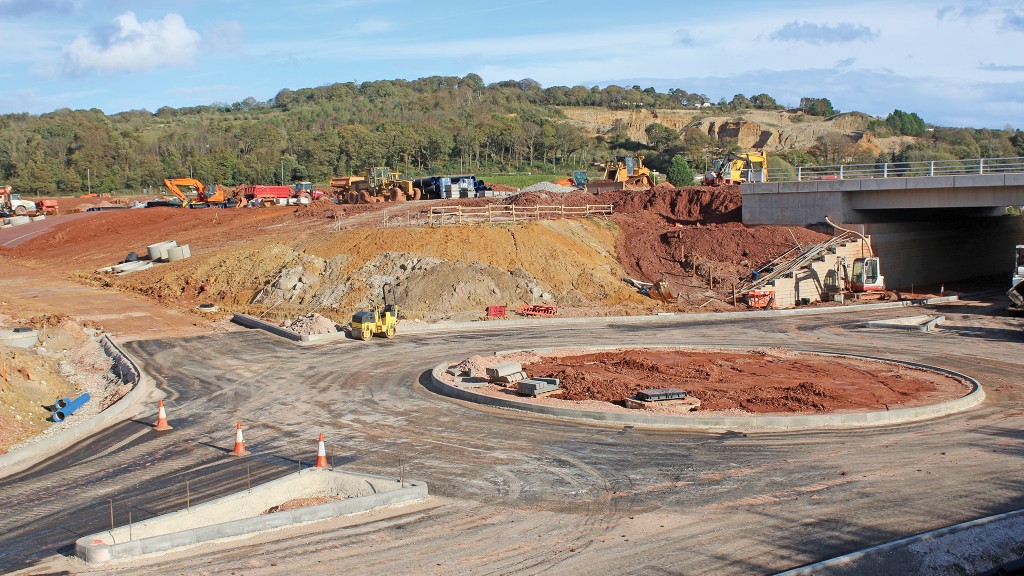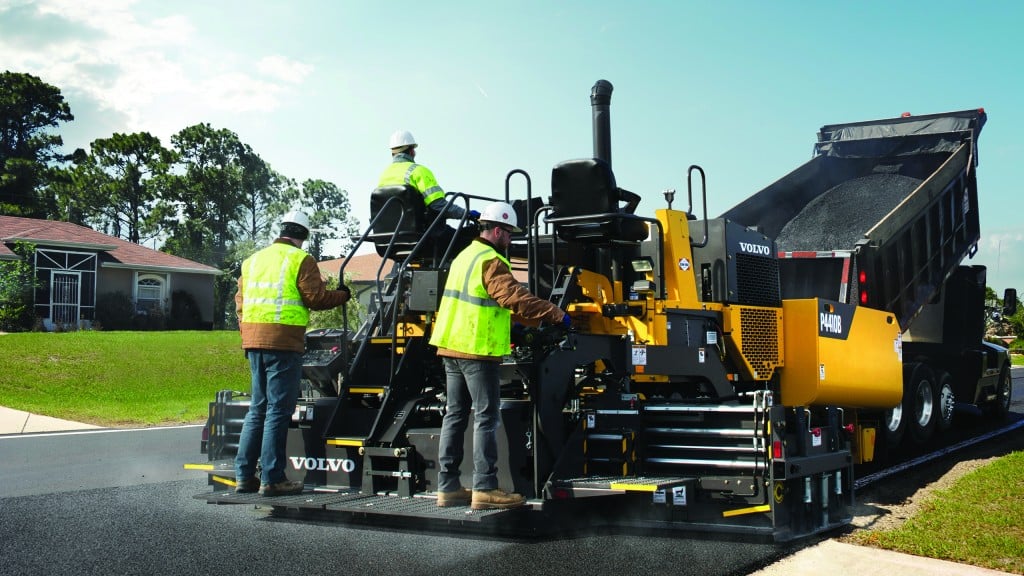Straight talk on paving roundabouts
Traffic flow, proper mix, automatic grade control all top tips for roundabout construction

A popular traffic management approach in Europe for many years, roundabout intersections are becoming a regular sight on North American roads. The safety aspect of roundabouts, which reduce injury crashes and fatalities by a significant amount over traditional signalled intersections, are a big draw for road planners at all levels.
Roundabouts, however, are a little more complicated to construct and pave than regular intersections. The flow of traffic on roundabouts can mean different wear and tear on road surfaces, and thus it is important to plan a roundabout paving construction project carefully, use the right asphalt mixes and compact surfaces in a way that ensures longevity.
Traffic flow consideration critical for roundabout planning
Paving crews working on roundabout projects must be aware that everything from traffic movement to construction itself can cause problems with road surfaces, according to Todd Mansell, a paving product application specialist with Caterpillar.
"The wheels are turning, the vehicles are putting forces on the pavement - a lot more lateral force or stress strain on that asphalt pavement compared to a straight roadway. And, we have a lot of traffic with acceleration, stops and starts along the approaches," Mansell said. "It can be difficult to perform the paving because of the many joints involved, longitudinal and transverse, and all the approaches."
Plan ahead for roundabout construction
Good pavement relies on a good base, so it's important that the condition of the road base be considered before paving starts. If rehabilitating an existing roundabout, milling the full surface is highly recommended. For paving a new roundabout, ensure that the aggregate base is protected from damage and grading plans are in place to ensure proper drainage.
"Base repairs on a roundabout are more difficult to go back and do afterward, and get everything to match," Mansell noted.
Truck movement should be planned early to reduce strain on the base, and truck drivers should be warned to avoid too many trips onto potentially fragile base courses.
The base design also ties in to drainage - the grading plan needs to be precise to ensure water moves in the right directions, rather than pooling on the roadway. While straight roads only require water to drain left and right, roundabouts have drainage all the way around the circle, as well as having to deal with water from tie-ins and elsewhere.
"It's very important to get the grading plan correct and make sure the base is right before we get into paving. I can't overemphasize checking that," Mansell said.
Select the correct asphalt mix for paving roundabouts
Another consideration is the type of asphalt that will be used for the roundabout project. With the amount of turning traffic, rutting and shoving of material can occur, so it's important to choose a mix that can handle such pressures.
"We want a stable mix with a high crush count of rock or aggregate in the design," Mansell said. "Most Superpave mixes nowadays meet that criteria, so it's not really a huge factor, but you also need to be sure to get good compaction or density on that material after we put it down."
Choosing the direction in which to pave roundabouts is relatively simple - look at how traffic normally flows through the intersection and follow it, to start off.
"If we're looking at a single lane roundabout, a general rule of thumb is to pave through in the direction of highest traffic flow or volume," he said. For example, if the main flow of traffic enters an intersection from the north, it's best to start there and pave counter clockwise to match the way in which the most traffic pressure will move.
Paving multiple lanes is a little more complex. Mansell suggests starting from the outside and working inward, allowing for easier connection with roadways entering the roundabout and offering an anchor point - the island at the middle - for the paver when on the inside.
Echelon paving reduces potential joint pain
An even better approach, when possible, is to plan for echelon paving.
"If it's multi-lane, with two lanes in the roundabout, try to run two pavers side by side so you get a hot joint - it makes the compaction process easier, and we do end up with longitudinal joints," Mansell said. The process is also a good way to ensure that drainage plans and grades are met effectively.
It's also a good idea to pave tie-in connections first, and then the circular part of roundabouts, Mansell suggested. That ensures that the roads coming in to the roundabout are at the right level to meet the asphalt being laid down in the circle, providing for better joints and less potential problems.
One of the most important tips Mansell offered for paving roundabouts is the use of automatic grade and slope control on pavers. The use of automatics helps in ensuring that joints are properly matched and grades are correct without costly repairs in the near future.
"Using automated grade and slope control is really going to help on that joint match, because it's a little trickier to eyeball and match manually when you're paving through a curve as opposed to looking at a conventional straight-on roadway," he noted.
Keep paver set-up in mind
Consideration should also be given to the set-up of the paver for the job, as well. Crews familiar with paving cul-de-sacs will be familiar with the concept - the outside edge of the screed moves faster than the inside edge, leading to potential feed issues.
"We've really got to think about the feed system on the paver, bringing that mix back on the conveyors to the screed and spreading that mix across the face as we pave," Mansell said. "You tend to have to overfeed that outside edge that's moving faster, to keep the screed supported . . . but that can lead to bumps and irregularities in the mat."
Auger and tunnel extensions are a good way to ensure that mix is moved to the outside edge where possible. In cases where the screed is prone to dropping on the inside or outside edge, systems that lock it in place can be helpful - though they affect compaction and density, so should be used sparingly.
Considerations for compaction operation
Once the asphalt is placed, it's time for the rollers to move in, but on roundabouts compactors need to be cautious not to push material or leave ruts due to the compaction pattern used.
"Just like the screed on the paver, when the roller makes a turn, the outside edge of that drum wants to turn faster than the inside edge," Mansell noted.
The choice of roller type can make a difference in the quality of compaction on roundabouts. Narrower drums than normally used on straight road or highway projects may minimize tearing and checking in the mat as they go through turns. Split drum rollers are a good option - they allow drums to operate independently when working on tight turns. Combination rollers also provide some potential benefit, thanks to the rubber tires kneading together any checking or cracking being caused by the roller.
Echelon paving helps compaction work by giving rollers a broader area to compact without making aggressive turns, Mansell noted. Doing the compaction work in a piecemeal approach - keeping passes straight, rather than making broad turns - keeps pushing, tearing and other potential issues at a minimum.
All in all, roundabouts provide plenty of challenge for paving crews, but some planning and preparation, along with selecting the right equipment and tools for the job, all help in ensuring a clean, complete and high-quality finished roadway.



